Speaker
Description
nEXO is a next-generation neutrinoless double-beta decay experiment that is searching for this decay in 5-tonnes of liquid xenon (LXe) enriched in the isotope 136Xe. Silicon-photomultipliers have been selected to measure the vacuum ultraviolet (VUV) scintillation light from interactions within the LXe. Although candidate SiPMs from Hamamatsu (HPK) and FBK have been characterised within the collaboration and shown to meet nEXOs performance requirements, the long-term stability of their detection efficiency, gain, and correlated noise under VUV exposure has not been thoroughly reported. To investigate long term effects under VUV exposure, a sample of HPK VUV4 SiPMs were irradiated with a flash lamp. The performance of the SiPMs were then reevaluated following repeated VUV exposure. This process was repeated with increasing dose until far exceeding the expected exposure from 10 years of nEXO run time. I will report on the stability of the PDE, gain, and correlated noise for a sample of HPK VUV4 SiPMs following a large dose of VUV radiation.

